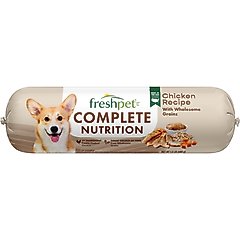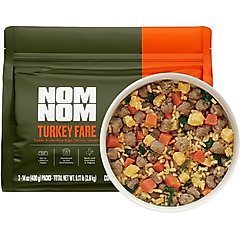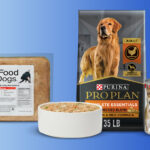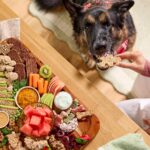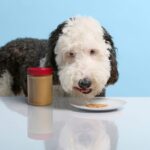How Much Fresh Food to Feed a Dog

Photo by Chewy
Fresh dog food is gaining popularity among pet parents who appreciate the importance of good nutrition—but deciding what type is only half the battle. Equally important is determining how much fresh food to feed a dog.
Too much food and your dog will become overweight. Too little and they can become too skinny and suffer from nutritional deficiencies.
It’s best to get recommendations from your veterinarian that are tailored specifically to your dog’s needs. Here’s what you need to know about feeding your dog the correct amount for them.
Key Takeaways
- How much fresh food your dog needs depends on factors like age, size, and activity level.
- Fresh dog foods vary widely in format and calorie density, so feeding amounts differ.
- Use your veterinarian’s recommendations, feeding charts, and product labels to help determine the right portion sizes.
- Regularly assess your dog’s body condition, and consult your vet if you notice any major changes.
How Much Fresh Food Should I Feed My Dog
Several factors determine how much fresh food your dog needs:
- Age: Puppies are growing fast, so they need more calories, protein, and other nutrients than adult dogs.
- Size: Bigger dogs eat more than smaller ones.
- Activity level: Active dogs burn more calories and need extra food.
- Reproductive status: Spayed and neutered dogs typically need fewer calories. But if your dog is pregnant or nursing puppies, she’ll need extra food to keep herself and her babies healthy.
- Body condition: Overweight dogs should eat less to slim down, while underweight dogs need more food to reach a healthy weight.
- Type of food: Some dog foods are packed with calories and nutrients, so you don’t need to feed as much compared to less dense options.
Keep in mind that your dog’s needs will vary as they age, or if their health or lifestyle changes. And every dog is an individual: What works perfectly for your neighbor’s dog might not be right for yours.
Comparing Fresh Dog Food to Other Diets
Another complicating factor with fresh dog foods is the sheer variety of available types that are available.
There are frozen fresh foods, refrigerated fresh foods, air-dried fresh foods, foods that come in tubes, foods that come in bags—so many options! As a result, comparing them to other foods and even to each other gets complicated.
With that said, there are a few important differences between traditional dog foods and fresh dog foods to be aware of:
- Dogs usually love the taste of fresh foods, so they may want to overeat.
- Fresh foods are highly digestible, so you may need to feed less than you expect.
- Highly digestible foods also usually lead to less poop.
- To avoid nutritional excesses and deficiencies, only purchase complete and balanced fresh dog foods.
- Fewer (or no) preservatives make the proper storage of fresh dog food especially important.
Fresh Dog Food Feeding Chart
To determine how much fresh food to feed your dog, you need to know how many calories they should be taking in each day. This chart can give you an idea of what is typical for a spayed or neutered adult dog at different weights.
| Dog’s Ideal Weight | Average Caloric Intake |
|---|---|
| 5 lbs | 210 kcal/day (Range: 105 - 315 kcal/day) |
| 10 lbs | 346 kcal/day (Range: 173 - 519 kcal/day) |
| 15 lbs | 472 kcal/day (Range: 236 - 708 kcal/day) |
| 20 lbs | 587 kcal/day (Range: 294 - 881 kcal/day) |
| 25 lbs | 690 kcal/day (Range: 345 - 1035 kcal/day) |
| 30 lbs | 794 kcal/day (Range: 397 - 1191 kcal/day) |
| 35 lbs | 891 kcal/day (Range: 446 - 1337 kcal/day) |
| 40 lbs | 982 kcal/day (Range: 491 - 1473 kcal/day) |
| 45 lbs | 1075 kcal/day (Range: 538 - 1613 kcal/day) |
| 50 lbs | 1165 kcal/day (Range: 583 - 1748 kcal/day) |
| 60 lbs | 1334 kcal/day (Range: 667 - 2001 kcal/day) |
| 70 lbs | 1499 kcal/day (Range: 750 - 2249 kcal/day) |
| 80 lbs | 1656 kcal/day (Range: 828 - 2484 kcal/day) |
| 90 lbs | 1808 kcal/day (Range: 904 - 2712 kcal/day) |
| 100 lbs | 1958 kcal/day (Range: 979 - 2937 kcal/day) |
| 110 lbs | 2102 kcal/day (Range: 1051 - 3153 kcal/day) |
| 120 lbs | 2243 kcal/day (Range: 1122 - 3365 kcal/day) |
| 130 lbs | 2384 kcal/day (Range: 1192 - 3576 kcal/day) |
Use a feeding chart for puppies if your dog is under 12 months of age (18 months for very large breeds).
How to Calculate Fresh Food Portions
Some fresh dog foods, like Get Real, come in pre-portioned packaging designed for your dog. This saves pet parents the hassle of measuring out their pup’s meals each day.
You can also consult your veterinarian for help deciding how much fresh food to feed your dog at each meal.
If you do need to calculate portions, start by looking at the label of the fresh dog food that you have purchased. You should see the food’s calorie content in kcal/cup, pounds, or ounces.
Divide your dog’s caloric needs by the food’s caloric content to determine the appropriate daily portion in cups, pounds, or ounces.
Compare what you’ve calculated to the feeding instructions on the fresh dog food label, which could be written in a variety of ways. For example:
- Freshpet Complete Nutrition Chicken Recipe Fresh Dog Food marks cup measurements on the side of its tubes (but its feeding instructions are printed in pounds).
Recommended Product
- Nom Nom Freshly-Made Frozen Turkey Fare Dog Food recommends that you feed “1 cup daily per 10 lb. of body weight. Increase for active dogs. Double or triple this amount for puppies and pregnant or lactating dogs.”
Recommended Product
- The Pets Table Freshly-Made Frozen Human-Grade Beef Stew Dog Food provides a feeding chart based on fractions of their food containers.
Recommended Product
Your calculations and the fresh dog food’s feeding instructions should be in the same ballpark.
Divide your dog’s daily meal allowance by the number of meals you feed each day. For example, if you feed your pup twice per day, you may want to feed half in the morning and half at night.
Check your dog’s body -condition score monthly to fine-tune how much food you are offering each day. If they’re getting a little too skinny, feed more. If they’re gaining too much weight, feed less. And as always, talk to your veterinarian if you have questions about your dog’s diet or health.

